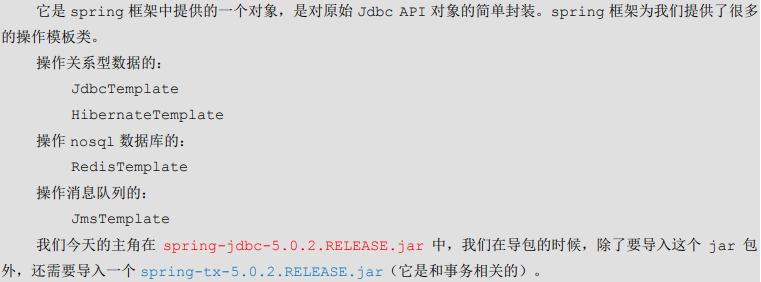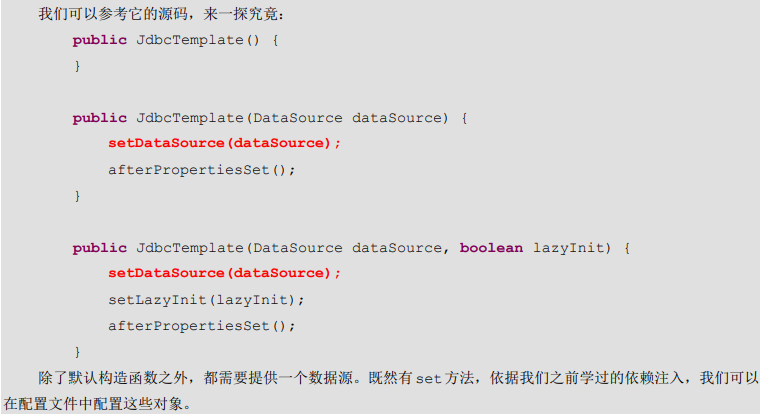Spring06_JdbcTemplate
1、JdbcTemplate介绍

2、JdbcTemplate对象的创建

3、Spring中配置数据源
1)jar包导入

2)编写spring的配置文件
<?xml version="1.0" encoding="UTF-8"?> <beans xmlns="http://www.springframework.org/schema/beans" xmlns:xsi="http://www.w3.org/2001/XMLSchema-instance" xsi:schemaLocation="http://www.springframework.org/schema/beans http://www.springframework.org/schema/beans/spring-beans.xsd"> </beans>
3)配置数据源
配置数据源的方式有很多种,比如cp30和DBCP,要想使用都需要导入对应的jar包
① 配置CP30数据源
导入cp30jar包,然后在spring文件中配置
<bean id="dataSource" class="com.mchange.v2.c3p0.ComboPooledDataSource"> <property name="driverClass" value="com.mysql.jdbc.Driver"></property> <property name="jdbcUrl" value="jdbc:mysql:///spring_day02"></property> <property name="user" value="root"></property> <property name="password" value="1234"></property> </bean>
② 配置DBCP数据源
导入对应jar包,然后在spring配置文件中配置
<bean id="dataSource" class="org.apache.commons.dbcp.BasicDataSource"> <property name="driverClassName" value="com.mysql.jdbc.Driver"></property> <property name="url" value="jdbc:mysql:// /spring_day02"></property> <property name="username" value="root"></property> <property name="password" value="1234"></property> </bean>
③ 配置spring内置数据源JdbcTemplate
spring 框架也提供了一个内置数据源,我们也可以使用 spring 的内置数据源,它就在 spring-jdbc-5.0.2.REEASE.jar 包中:
<bean id="dataSource" class="org.springframework.jdbc.datasource.DriverManagerDataSource"> <property name="driverClassName" value="com.mysql.jdbc.Driver"></property> <property name="url" value="jdbc:mysql:///spring_day02"></property> <property name="username" value="root"></property> <property name="password" value="1234"></property> </bean>
拓展:将数据库信息配置到数据文件中后,如何引入
定义属性文件jdbc.properties:
jdbc.driverClass=com.mysql.jdbc.Driver
jdbc.url=jdbc:mysql:///spring_day02
jdbc.username=root
jdbc.password=123
引入:
一种方式: <!-- 引入外部属性文件: --> <bean class="org.springframework.beans.factory.config.PropertyPlaceholderConfigurer"> <property name="location" value="classpath:jdbc.properties"/> </bean> 另一种方式: <context:property-placeholder location="classpath:jdbc.properties"/>
4、JdbcTemplate的CRUD操作
1)准备
创建数据库:
create database spring_day02;
use spring_day02;
创建表:
create table account(
id int primary key auto_increment,
name varchar(40),
money float
)character set utf8 collate utf8_general_ci;
2)在spring配置文件中配置JdbcTemplate数据源
<?xml version="1.0" encoding="UTF-8"?> <beans xmlns="http://www.springframework.org/schema/beans" xmlns:xsi="http://www.w3.org/2001/XMLSchema-instance" xsi:schemaLocation="http://www.springframework.org/schema/beans http://www.springframework.org/schema/beans/spring-beans.xsd"> <!-- 配置一个数据库的操作模板:JdbcTemplate --> <bean id="jdbcTemplate" class="org.springframework.jdbc.core.JdbcTemplate"> <property name="dataSource" ref="dataSource"></property> </bean> <!-- 配置数据源 --> <bean id="dataSource" class="org.springframework.jdbc.datasource.DriverManagerDataSource"> <property name="driverClassName" value="com.mysql.jdbc.Driver"></property> <property name="url" value="jdbc:mysql:///spring_day02"></property> <property name="username" value="root"></property> <property name="password" value="1234"></property> </bean> </beans>
3)基本使用
public static void main(String[] args) { //1.获取 Spring 容器 ApplicationContext ac = new ClassPathXmlApplicationContext("bean.xml"); //2.根据 id 获取 bean 对象 JdbcTemplate jt = (JdbcTemplate) ac.getBean("jdbcTemplate"); //3.执行操作 jt.execute("insert into account(name,money)values('eee',500)"); }
4)保存操作
jt.update("insert into account(name,money)values(?,?)","fff",5000);
5)更新操作
jt.update("update account set money = money-? where id = ?",300,6);
6)删除操作
jt.update("delete from account where id = ?",6);
7)查询所有
public class JdbcTemplateDemo3 { public static void main(String[] args) { //1.获取 Spring 容器 ApplicationContext ac = new ClassPathXmlApplicationContext("bean.xml"); //2.根据 id 获取 bean 对象 JdbcTemplate jt = (JdbcTemplate) ac.getBean("jdbcTemplate"); //3.执行操作 //查询所有 List<Account> accounts = jt.query("select * from account where money > ? ", new AccountRowMapper(), 500); for(Account o : accounts){ System.out.println(o); } } } public class AccountRowMapper implements RowMapper<Account>{ @Override public Account mapRow(ResultSet rs, int rowNum) throws SQLException { Account account = new Account(); account.setId(rs.getInt("id")); account.setName(rs.getString("name")); account.setMoney(rs.getFloat("money")); return account; }
}
8)查询一个
使用 RowMapper 的方式:常用的方式 public class JdbcTemplateDemo3 { public static void main(String[] args) { //1.获取 Spring 容器 ApplicationContext ac = new ClassPathXmlApplicationContext("bean.xml"); //2.根据 id 获取 bean 对象 JdbcTemplate jt = (JdbcTemplate) ac.getBean("jdbcTemplate"); //3.执行操作 //查询一个 List<Account> as = jt.query("select * from account where id = ? ", new AccountRowMapper(), 55); System.out.println(as.isEmpty()?"没有结果":as.get(0)); } } 使用 ResultSetExtractor 的方式:不常用的方式 public class JdbcTemplateDemo3 { public static void main(String[] args) { //1.获取 Spring 容器 ApplicationContext ac = new ClassPathXmlApplicationContext("bean.xml"); //2.根据 id 获取 bean 对象 JdbcTemplate jt = (JdbcTemplate) ac.getBean("jdbcTemplate"); //3.执行操作 //查询一个 Account account = jt.query("select * from account where id = ?",new AccountResultSetExtractor(),3); System.out.println(account); } }
9)查询返回一行一列
//查询返回一行一列:使用聚合函数,在不使用 group by 字句时,都是返回一行一列。最长用的 就是分页中获取总记录条数 Integer total = jt.queryForObject("select count(*) from account where money > ? ",Integer.class,500);
5、dao中使用JdbcTemplate
1)准备实体类
public class Account implements Serializable { private Integer id; private String name; private Float money; get/set/toString }
2)方式一:在DAO中定义JdbcTemplate
/** * 账户的持久层实现类 * 此版本的 dao,需要给 dao 注入 JdbcTemplate */ public class AccountDaoImpl implements IAccountDao { private JdbcTemplate jdbcTemplate; public void setJdbcTemplate(JdbcTemplate jdbcTemplate) { this.jdbcTemplate = jdbcTemplate; } @Override public Account findAccountById(Integer id) { List<Account> list = jdbcTemplate.query("select * from account where id = ? ",new AccountRowMapper(),id); return list.isEmpty()?null:list.get(0); } @Override public Account findAccountByName(String name) { List<Account> list = jdbcTemplate.query("select * from account where name = ? ",new AccountRowMapper(),name); if(list.isEmpty()){ return null; } if(list.size()>1){ throw new RuntimeException("结果集不唯一,不是只有一个账户对象"); } return list.get(0); } @Override public void updateAccount(Account account) { jdbcTemplate.update("update account set money = ? where id = ? ",account.getMoney(),account.getId()); } }
配置文件 <?xml version="1.0" encoding="UTF-8"?> <beans xmlns="http://www.springframework.org/schema/beans" xmlns:xsi="http://www.w3.org/2001/XMLSchema-instance" xsi:schemaLocation="http://www.springframework.org/schema/beans http://www.springframework.org/schema/beans/spring-beans.xsd"> <!-- 配置一个 dao --> <bean id="accountDao" class="dao.impl.AccountDaoImpl"> <!-- 注入 jdbcTemplate --> <property name="jdbcTemplate" ref="jdbcTemplate"></property> </bean> <!-- 配置一个数据库的操作模板:JdbcTemplate --> <bean id="jdbcTemplate" class="org.springframework.jdbc.core.JdbcTemplate"> <property name="dataSource" ref="dataSource"></property> </bean> <!-- 配置数据源 --> <bean id="dataSource" class="org.springframework.jdbc.datasource.DriverManagerDataSource"> <property name="driverClassName" value="com.mysql.jdbc.Driver"></property> <property name="url" value="jdbc:mysql:///spring_day04"></property> <property name="username" value="root"></property> <property name="password" value="1234"></property> </bean> </beans>
思考:这种方式的问题
有个小问题。就是我们的 dao 有很多时,每个 dao 都有一些重复性的代码。下面就是重复代码: private JdbcTemplate jdbcTemplate; public void setJdbcTemplate(JdbcTemplate jdbcTemplate) { this.jdbcTemplate = jdbcTemplate; }
3)方式二:让DAO继承JdbcDaoSupport
JdbcDaoSupport 是 spring 框架为我们提供的一个类,该类中定义了一个 JdbcTemplate 对象,我们可以直接获取使用,但是要想创建该对象,需要为其提供一个数据源:具体源码如下: public abstract class JdbcDaoSupport extends DaoSupport { //定义对象 private JdbcTemplate jdbcTemplate; //set 方法注入数据源,判断是否注入了,注入了就创建 JdbcTemplate public final void setDataSource(DataSource dataSource) { if (this.jdbcTemplate == null || dataSource != this.jdbcTemplate.getDataSource()) { //如果提供了数据源就创建 JdbcTemplate this.jdbcTemplate = createJdbcTemplate(dataSource); initTemplateConfig(); } } //使用数据源创建 JdcbTemplate protected JdbcTemplate createJdbcTemplate(DataSource dataSource) { return new JdbcTemplate(dataSource); } //当然,我们也可以通过注入 JdbcTemplate 对象 public final void setJdbcTemplate(JdbcTemplate jdbcTemplate) { this.jdbcTemplate = jdbcTemplate; initTemplateConfig(); } //使用 getJdbcTmeplate 方法获取操作模板对象 public final JdbcTemplate getJdbcTemplate() { return this.jdbcTemplate; }
/** * 账户的持久层实现类 * 此版本 dao,只需要给它的父类注入一个数据源 */ public class AccountDaoImpl2 extends JdbcDaoSupport implements IAccountDao { @Override public Account findAccountById(Integer id) { //getJdbcTemplate()方法是从父类上继承下来的。 List<Account> list = getJdbcTemplate().query("select * from account where id = ? ",new AccountRowMapper(),id); return list.isEmpty()?null:list.get(0); } @Override public Account findAccountByName(String name) { //getJdbcTemplate()方法是从父类上继承下来的。 List<Account> list = getJdbcTemplate().query("select * from account where name = ? ",new AccountRowMapper(),name); if(list.isEmpty()){ return null; } if(list.size()>1){ throw new RuntimeException("结果集不唯一,不是只有一个账户对象"); } return list.get(0); } @Override public void updateAccount(Account account) { //getJdbcTemplate()方法是从父类上继承下来的。 getJdbcTemplate().update("update account set money = ? where id = ? ",account.getMoney(),account.getId()); } }
配置文件: <?xml version="1.0" encoding="UTF-8"?> <beans xmlns="http://www.springframework.org/schema/beans" xmlns:xsi="http://www.w3.org/2001/XMLSchema-instance" xsi:schemaLocation="http://www.springframework.org/schema/beans http://www.springframework.org/schema/beans/spring-beans.xsd"> <!-- 配置 dao2 --> <bean id="accountDao2" class="dao.impl.AccountDaoImpl2"> <!-- 注入 dataSource --> <property name="dataSource" ref="dataSource"></property> </bean> <!-- 配置数据源 --> <bean id="dataSource" class="org.springframework.jdbc.datasource.DriverManagerDataSource"> <property name="driverClassName" value="com.mysql.jdbc.Driver"></property> <property name="url" value="jdbc:mysql:///spring_day04"></property> <property name="username" value="root"></property> <property name="password" value="1234"></property> </bean> </beans>
思考:两版 Dao 有什么区别呢?
第一种在 Dao 类中定义 JdbcTemplate 的方式,适用于所有配置方式(xml 和注解都可以)。
第二种让 Dao 继承 JdbcDaoSupport 的方式,只能用于基于 XML 的方式,注解用不了。






【推荐】国内首个AI IDE,深度理解中文开发场景,立即下载体验Trae
【推荐】编程新体验,更懂你的AI,立即体验豆包MarsCode编程助手
【推荐】抖音旗下AI助手豆包,你的智能百科全书,全免费不限次数
【推荐】轻量又高性能的 SSH 工具 IShell:AI 加持,快人一步
· 阿里巴巴 QwQ-32B真的超越了 DeepSeek R-1吗?
· 10年+ .NET Coder 心语 ── 封装的思维:从隐藏、稳定开始理解其本质意义
· 【设计模式】告别冗长if-else语句:使用策略模式优化代码结构
· 字符编码:从基础到乱码解决
· 提示词工程——AI应用必不可少的技术